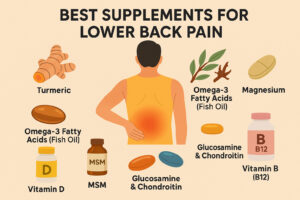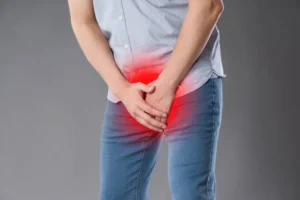Lower back pain is one of the most common health complaints worldwide, affecting millions of people daily. Whether it’s from long hours at a desk, heavy lifting, sports injuries, or simply the wear and tear of aging, back pain can significantly reduce your quality of life. For many, the first instinct is to turn to painkillers, but these only mask the symptoms rather than supporting true healing.
Supplements offer a more natural, long-term approach by targeting the root causes of lower back pain, such as inflammation, poor joint health, muscle tension, and nutrient deficiencies. The right combination of vitamins, minerals, and herbal extracts can help reduce pain, improve flexibility, and restore your ability to move without discomfort.
In this guide, we’ll explore the best supplements for lower back pain that actually work, explain how they help, and provide actionable tips on choosing the right ones for your needs. We’ll also cover recommended dosages, possible side effects, and key things to look for when buying supplements.
In This Article
Why Supplements Can Help With Lower Back Pain
Many people with lower back pain suffer due to inflammation, weakened connective tissue, or poor muscle recovery. Supplements can address these issues in the following ways:
- Reducing inflammation: Natural anti-inflammatory compounds like turmeric and omega-3s help calm pain at the source.
- Supporting joint health: Ingredients like glucosamine and chondroitin promote cartilage repair.
- Improving muscle recovery: Magnesium and amino acids aid in faster muscle healing after strain.
- Enhancing nerve function: B vitamins and alpha-lipoic acid protect and repair nerve tissues.
- Balancing nutrient deficiencies: Vitamin D and calcium maintain bone health, reducing structural strain.
Top Supplements for Lower Back Pain in 2025
Here’s a quick reference table before we explore each in detail.
| Supplement | Key Benefit | How It Helps Lower Back Pain | Typical Dosage |
|---|---|---|---|
| Turmeric Curcumin | Potent anti-inflammatory | Reduces joint and muscle inflammation | 500–1,000 mg daily |
| Omega-3 Fish Oil | Joint and tissue health | Supports lubrication and reduces stiffness | 1,000–3,000 mg daily |
| Glucosamine & Chondroitin | Cartilage repair | Improves mobility and reduces joint pain | 1,500 mg glucosamine & 1,200 mg chondroitin daily |
| Magnesium | Muscle relaxation | Eases spasms and improves recovery | 300–400 mg daily |
| Vitamin D3 | Bone strength | Prevents bone weakness that worsens back pain | 1,000–2,000 IU daily |
| Collagen Peptides | Connective tissue repair | Supports ligaments, tendons, and discs | 5–10 g daily |
| Boswellia Serrata | Anti-inflammatory | Blocks pain-causing enzymes | 300–500 mg daily |
| B Vitamins | Nerve health | Protects and repairs nerve tissues | B-complex daily |
1. Turmeric Curcumin – Nature’s Anti-Inflammatory Powerhouse
Turmeric, specifically its active compound curcumin, is widely recognized for its powerful anti-inflammatory properties. Chronic inflammation is a key driver of lower back pain, particularly in conditions like arthritis, herniated discs, or muscle strain.
Regular turmeric supplementation helps reduce swelling and stiffness, making movement easier and less painful. For best results, choose a supplement with black pepper extract (piperine), which boosts absorption significantly.
Benefits:
- Reduces inflammation naturally
- Improves joint flexibility
- May lower the need for painkillers
Tip: Go for 95% curcuminoid extracts for maximum effectiveness.
2. Omega-3 Fish Oil – Lubricating Joints and Reducing Stiffness
Omega-3 fatty acids (EPA and DHA) from fish oil are essential for joint lubrication and reducing inflammation. They can help relieve stiffness in the lower back caused by arthritis or disc degeneration.
These healthy fats also improve blood circulation, which supports healing in damaged muscles and ligaments.
Benefits:
- Reduces stiffness in the spine
- Promotes tissue repair
- Supports overall joint health
Tip: Opt for high-quality fish oil with at least 1,000 mg combined EPA and DHA per serving.
3. Glucosamine and Chondroitin – Rebuilding the Foundation
Glucosamine and chondroitin are building blocks of cartilage, the cushioning material in joints. For those whose lower back pain is linked to spinal disc wear, these compounds can help slow deterioration and improve mobility.
They also provide lubrication, making movements smoother and less painful.
Benefits:
- Restores cartilage structure
- Reduces joint space narrowing
- Improves overall spinal health
Tip: It may take a few weeks to notice results, so be consistent.
4. Magnesium – Muscle Relaxation and Recovery
Muscle spasms are a common cause of lower back pain. Magnesium plays a vital role in muscle relaxation, nerve function, and energy production.
A magnesium deficiency can lead to increased tension and cramping in the lower back muscles, prolonging discomfort. Supplementing can ease these symptoms while supporting recovery.
Benefits:
- Relaxes tight muscles
- Supports nerve function
- Improves sleep quality, aiding healing
Tip: Magnesium citrate or glycinate are more easily absorbed than magnesium oxide.
5. Vitamin D3 – Strengthening Bones and Spine
Vitamin D3 is essential for calcium absorption, which is crucial for bone strength. Low levels of vitamin D are linked to increased back pain, especially in older adults.
By maintaining healthy bone density, vitamin D3 helps prevent structural issues that contribute to pain.
Benefits:
- Strengthens bones and spine
- Reduces risk of fractures
- Supports immune function for overall health
Tip: Take with healthy fats for better absorption.
6. Collagen Peptides – Repairing Connective Tissue
Collagen is the most abundant protein in the body, responsible for the structure of ligaments, tendons, and spinal discs. As we age, collagen production declines, leading to weakened support structures in the back.
Supplementing with collagen peptides can promote tissue repair, improve flexibility, and reduce discomfort.
Benefits:
- Strengthens ligaments and tendons
- Supports disc health
- Improves mobility over time
Tip: Hydrolyzed collagen is easier for the body to absorb.
7. Boswellia Serrata – Herbal Pain Relief
Boswellia serrata, also known as Indian frankincense, contains boswellic acids that block enzymes responsible for inflammation and pain.
It’s particularly helpful for those with chronic lower back pain caused by arthritis or muscle strain.
Benefits:
- Potent natural painkiller
- Reduces stiffness
- Supports joint function
Tip: Look for standardized extracts with 65% boswellic acids.
8. B Vitamins – Nerve Protection and Repair
Vitamin B12, B6, and B1 play essential roles in nerve function and repair. If your lower back pain is due to nerve compression, such as sciatica, B vitamins can help relieve symptoms and promote healing.
They also support energy production, which helps the body recover faster from injuries.
Benefits:
- Protects nerve health
- Supports pain signal regulation
- Enhances muscle coordination
Tip: A balanced B-complex supplement ensures you get all the essential B vitamins in the right proportions.
How to Choose the Right Supplement for Lower Back Pain
When selecting a supplement, keep these tips in mind:
- Check ingredient quality – Look for third-party tested products.
- Avoid unnecessary fillers – Choose clean formulas without artificial additives.
- Consider combination formulas – Some products blend multiple pain-relieving and joint-supporting ingredients.
- Match to your pain cause – For muscle spasms, magnesium may help more; for arthritis, glucosamine and turmeric are better choices.
Potential Side Effects and Safety Considerations
While supplements are generally safe, it’s important to note possible side effects:
- Turmeric: May cause stomach upset in high doses
- Fish oil: Can thin blood; avoid before surgery
- Glucosamine: Not suitable for those allergic to shellfish
- Magnesium: Too much can cause diarrhoea
- Vitamin D: Excessive doses can lead to toxicity
Always speak to a healthcare professional before starting any new supplement, especially if you’re taking medication or have a chronic condition.
Best Practices for Taking Supplements
To get the most from your supplements:
- Take them consistently
- Pair fat-soluble vitamins (D, K, E, A) with healthy fats
- Combine with a healthy diet rich in anti-inflammatory foods
- Stay hydrated to help nutrient absorption
Lifestyle Tips to Enhance Supplement Benefits
Supplements work best when paired with healthy habits:
- Stretch daily to maintain flexibility
- Strengthen core muscles to support the spine
- Maintain good posture to prevent strain
- Use ergonomic furniture to reduce pressure on the lower back
- Stay active with low-impact exercises like swimming or walking
Final Thoughts
Lower back pain can be a stubborn and frustrating problem, but the right supplements can make a noticeable difference. By targeting inflammation, strengthening connective tissues, and supporting muscle and nerve health, these natural solutions offer a safe and effective way to regain mobility and reduce discomfort.
When choosing the best supplements for lower back pain, focus on quality, proven ingredients, and consistent use. Combine them with healthy lifestyle habits, and you’ll be taking a big step toward a pain-free back and a better quality of life.






